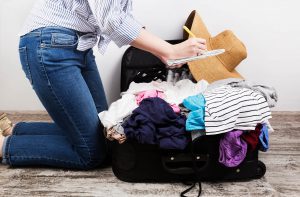So, you’ve just booked a trip to Africa for your first safari? Let the excitement commence! One of the greatest thrills of a lifetime is seeing Africa’s magnificent scenery and extraordinary wildlife in person, and we want to help prepare you for the experience. Below, we’ve curated a list of items you’ll need while on safari and any other necessary preparations you’ll need to account for so you can truly hone in on having the time of your life!
Travel Documents
For all international travel, it’s crucial to have the important and required documents prepared before your departure. This includes passports, all necessary visas, your health immunization record card, travel itinerary, and printed copies of your passport to keep somewhere else in your luggage, just in case. Please note that passports must be valid for up to 6 months after your travel dates.
Luggage
Before your trip, it is important to know what type of luggage is allowed on the safari/bush flights you will be taking. Because these planes are typically much smaller than large commercial flights, the cargo space below the planes is limited, so bags may need to be manipulated in order to fit and should have the flexibility to do so. We will help advise you based on what airline you are flying with, but typically a soft sided duffel bag is best. These can be found with wheels, for ease of use, but they must not have a hard rollerboard throughout the bag. Generally, weight restrictions range from 15-20kgs, so be sure your packed bag falls within those parameters. We also suggest using mesh packing cubes to keep your items organized since you may not have the opportunity to unpack fully when moving from lodge to lodge.
Dress Code
While there’s no official safari ‘dress code’, you definitely don’t need to look like the cast of Out of Africa. Comfort is key, as is anything durable or easy to wash (doesn’t require ironing, etc). It’s best to avoid bright colors while on safari because the goal is to blend in with your surroundings and safari vehicle as much as possible. When animals see the vehicle as one unit, as opposed to individual people, they are not disturbed. After seeing safari vehicles so often, the animals will view it as a part of their natural environment, so sticking to a neutral palette of khaki, green and beige is best. Be mindful that white isn’t the most practical color, as game drives can leave you both dusty and dirty and may leave stains on your clothes. In terms of a dress code while at the lodges, there aren’t typically any formalities and you can pack comfortable clothes for meals at the lodge or go straight to your meals from safari and not worry about changing into new clothes. Sandals or other footwear are permitted while at the lodge, while closed-toe shoes are encouraged on game drives. This is in case you are interested in participating in a walking safari or getting out of the vehicle for sundowner stops.
It is best to avoid dark colors like black and navy blue, as they can attract the tsetse fly (specifically in East Africa), which is responsible for transmitting African trypanosomiasis, alternatively known as ‘sleeping sickness’. Long sleeves also help with protection from tsetse fly, as their bite can be painful. They are much more prevalent in East Africa, and your safari guides will give you African ‘fly swatters’ to help keep them off of you. Fortunately, you won’t see them in Southern Africa. Camouflage is never a good idea because in most parts of Africa, the military (and oftentimes poachers) wear camouflage. It will draw unwanted attention and has even become illegal for civilians to wear camouflage in certain parts of Africa.
Other Tips
If you have sensitive skin, it’s recommended to wear long-sleeved blouses and shirts, even during summer in Africa, as they will protect you from sunburns and mosquito bites. It’s always important to wear comfortable clothes and fabrics that you can move well in and that are both quick-drying and well-ventilated. Additionally, be sure to pack plenty of layers: mornings and evenings (even during the warmer months) can be cooler, so having layers to start and end the day is important. As the weather warms up with the sun, you can take items off and stay comfortable in the heat of the day. A number of lodges offer a complimentary laundry service, which is extremely helpful in reducing the number of items while packing (and sticking to the strict weight limits for luggage). Laundry is usually a quick turn around (24 hours or less), which makes it easy for guests to pack only a few outfits and easily recycle through them.
Packing List

Our recommended breakdown, as far as an actual list for packing goes, is as follows (depending on the length of your stay):
Clothing:
- 2-4 comfortable short and long-sleeved shirts.
- 1-2 pairs of hiking pants and 1-2 pairs of shorts. Pants that convert into shorts (those with a zip at the knees) are good.
- Fleece or warm jacket
- A windbreaker jacket
- A light raincoat (season depending)
- Swimsuit if your lodge/hotel has a pool
- A wide-brimmed hat that is wide enough to cover your face, ears, and neck (baseball cap will also work)
- Undergarments and socks: we recommend bringing enough underwear for your entire trip or washing them yourself since it is sometimes considered taboo to include your underwear in your laundry in Africa (and some camps or lodges will not wash them). Laundry soap is usually provided in your room so you can hand wash any items you would like. Socks are fine to send through laundry services.
- Pajamas
- Athletic wear if you plan to use lodge gym facilities or exercise at all
Toiletries:
- Bring any medications that you might need while traveling, antibiotics in case of emergencies, and preventative vitamins to boost your immune system on long international flights. We like carrying antibacterial wipes to clean hard surfaces at your seat on long flights to kill any germs
- Lodges will provide shampoo, conditioner and lotions, so there is no need to pack these unless you prefer specific brands
- Normal travel toiletries otherwise
- Bug repellent, itch cream and sunscreen
- Lodges will have all necessary first aid items, but feel free to pack any must-have items in case
Shoes:
- If you aren’t doing any hiking or trekking, any comfortable closed toe shoe is fine (think tennis shoes or athletic shoes). If trekking or looking to do walking safaris, bring either high socks or shoes with a high ankle are helpful to protect against bugs, any brush or thorns while walking
Region Specific:
- For gorilla trekking, packing requirements are slightly different. For more information, read here: Guide to Gorilla Trekking in Rwanda
- In Kenya/Tanzania, there is a ban on plastic bags, which you should be aware of for packing purposes.
Technology
Africa differs from other countries in terms of their power and technology, so having an idea of which adapters/converters you will need for the countries you will be visiting is crucial. Africa uses 220-240 volt electricity at 50hz, and each country can have different plug types, so it’s important to verify the plug type for the countries you’re visiting before your trip. Many electronics are dual voltage these days, meaning they can operate on the 110 volts that the US operates on as well as 220 – 240 volts that much of the rest of the world operates on with only a plug adapter. Cell phone chargers, camera chargers and even laptop chargers are all dual voltage, and you will need nothing more than a plug adapter to plug them in. Items like hairdryers and flatirons often are not dual voltage and require a converter in order to use them, but you really won’t need them while you are in the bush. Be sure to bring cameras, photo equipment, chargers, extra memory cards, and batteries.
Safari Game Drive Bag
In a bumpy safari vehicle, it is helpful to have a smaller bag or backpack to keep with you and hold all the items you may need during your game drives. We recommend a bag that has zippers, in case you are going through bumpy terrain; things can fall out of the vehicle and are not easily found while you’re in the bush. We recommend keeping cameras, sunscreen, hats, extra layers, a water bottle and snacks with you on game drives. You will stop for a snack and beverage break during your game drives, so this isn’t necessary unless you like specific snacks or need to eat often.
Conclusion
The sheer magnificence of hearing a lion’s roar in person, gazing out at dramatic African landscapes, and witnessing wildlife up close are just a few of the things that make going on safari deeply unique and unforgettable, and we couldn’t be more thrilled that you are about to embark on one of the finest experiences Africa has to offer. As a result, we want your trip, both before and after, to be as hassle-free as possible. Our team is always prepared and equipped to answer any questions or address any concerns you may have about making sure you’re fully prepared for your trip. All we need you to focus on is having the best experience possible while on safari!
Related Posts



Start Planning Your Dream Trip
Reach out and let’s start talking. We’ll listen and begin to tailor an experiential, private, luxury vacation based on exactly how you want to experience Africa. From adventure to relaxation—and everything in between—let us handle every detail of your unforgettable journey.


